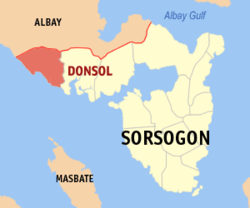Donsol | |
|---|---|
| Municipality of Donsol | |
 Port of Donsol | |
| Nickname: Whale Shark Tourism Capital of the Philippines | |
 Map of Sorsogon with Donsol highlighted | |
Location within the Philippines | |
| Coordinates: 12°54′30″N123°35′53″E / 12.9083°N 123.5981°E | |
| Country | Philippines |
| Region | Bicol Region |
| Province | Sorsogon |
| District | 1st district |
| Founded | 1668 |
| Barangays | 51 (see Barangays) |
| Government | |
| • Type | Sangguniang Bayan |
| • Mayor | Ralph Walter Lubiano |
| • Vice Mayor | Ma. Christiana R. Abetria |
| • Representative | Dette Escudero |
| • Municipal Council | Members |
| • Electorate | 32,811 voters (2025) |
| Area | |
• Total | 156.20 km2 (60.31 sq mi) |
| Elevation | 13 m (43 ft) |
| Highest elevation | 84 m (276 ft) |
| Lowest elevation | 0 m (0 ft) |
| Population (2024 census) [3] | |
• Total | 51,781 |
| • Density | 331.50/km2 (858.59/sq mi) |
| • Households | 11,262 |
| Demonym | Donsolanon |
| Economy | |
| • Income class | 3rd municipal income class |
| • Poverty incidence | 37.54 |
| • Revenue | ₱ 250.2 million (2022) |
| • Assets | ₱ 723.1 million (2022) |
| • Expenditure | ₱ 194.5 million (2022) |
| • Liabilities | ₱ 284.2 million (2022) |
| Service provider | |
| • Electricity | Sorsogon 2 Electric Cooperative (SORECO 2) |
| Time zone | UTC+8 (PST) |
| ZIP code | 4715 |
| PSGC | |
| IDD : area code | +63 (0)56 |
| Native languages |
|
Donsol, officially the Municipality of Donsol, (Central Bikol: Banwaan kan Donsol; Tagalog: Bayan ng Donsol) is a municipality in the province of Sorsogon, Philippines. According to the 2024 census, it has a population of 51,781 people. [5]
Contents
- Geography
- Barangays
- Climate
- Demographics
- Language
- Religion
- Economy
- Tourism
- Whale shark viewing
- Other attractions
- Education
- Primary and elementary schools
- Secondary schools
- References
- External links
It is known for whale shark encounters and its rich marine biodiversity, offering activities like snorkeling, diving, and wildlife exploration. [6]




